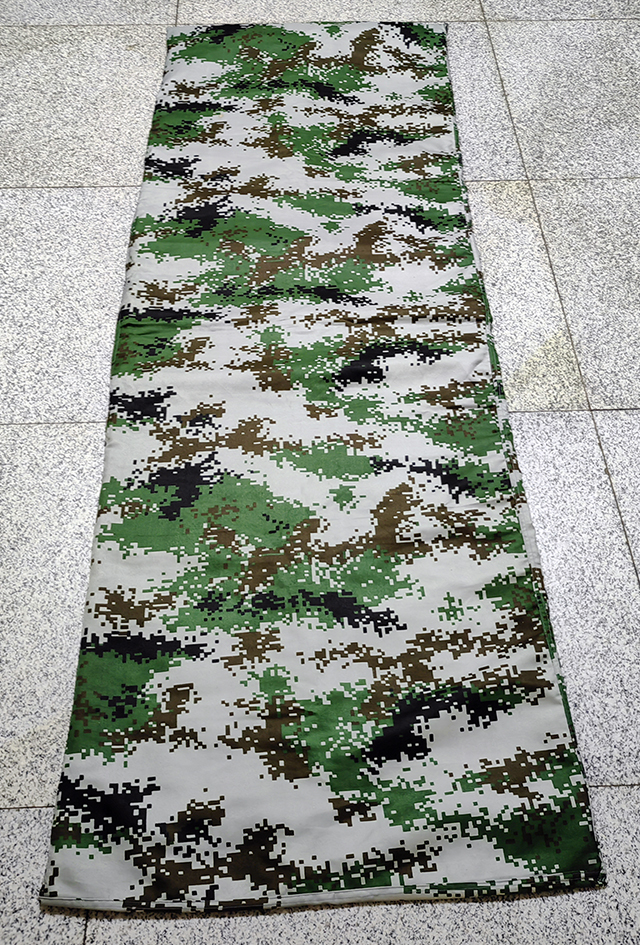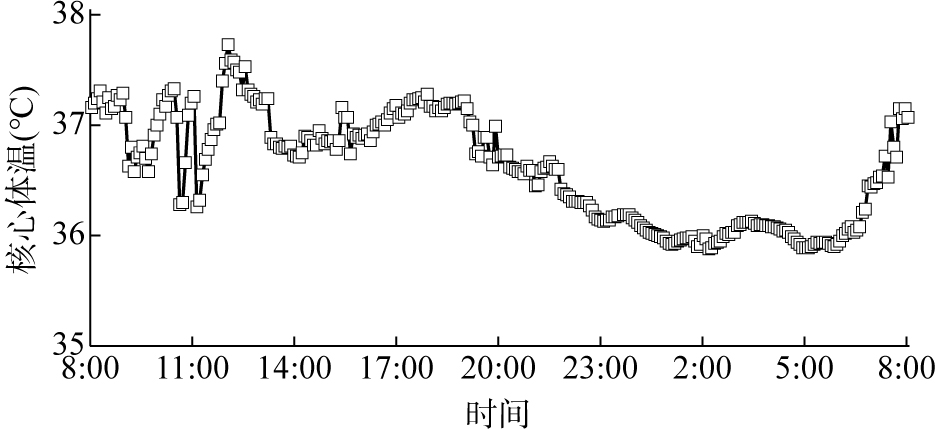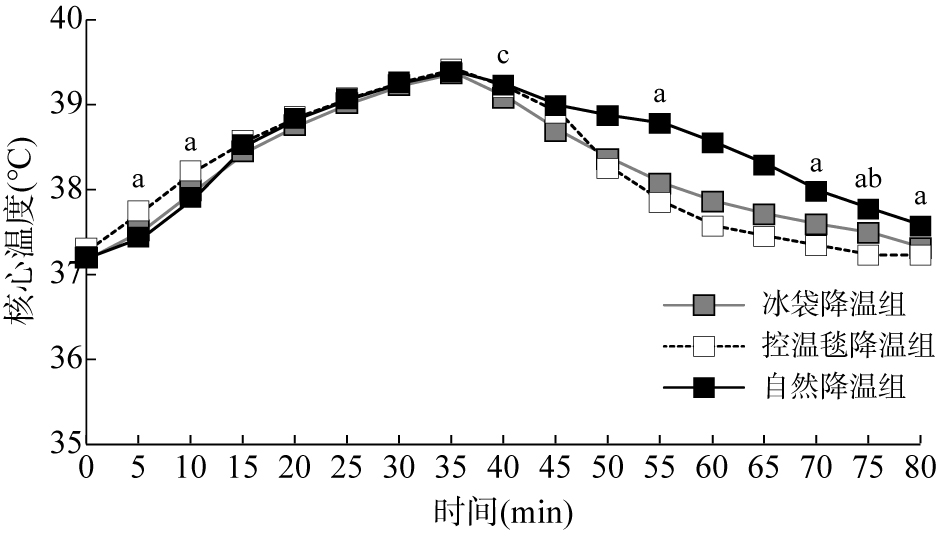Evaluation of cooling effect of temperature control blanket with phase change material after heat stress in military training
-
摘要:背景 在高温高湿环境下进行高强度的军事训练会造成机体核心体温升高,当机体核心体温持续升高超过机体散热能力时会造成机体损伤,严重时会发生热射病。快速降温可以减缓甚至逆转热损伤的发生。目的 探索相变材料控温毯在高强度训练热应激后的降温效果,为预防劳力性热相关疾病的发生提供依据。方法 收集2021年5 - 10月在某训练基地招募18 ~ 20岁男性参训人员18名,随机分为自然降温组、冰袋降温组、控温毯降温组,每组6人,口服测温胶囊后均按训练大纲负重10 kg在40 min内完成7 km跑步,自然降温组跑步完成后立即躺在地上,解开上衣扣,自然降温;冰袋降温组跑步完成后在颈部、腋窝、腹股沟各放置冰袋1个;控温毯降温组跑步完成后,立即躺在相变材料控温毯上降温;利用测温胶囊收集每名志愿者的核心温度,比较3种降温方式将体温降至37.5℃所需的时间;跑步完成1 h后对志愿者采用视觉模拟评分法评价降温方式舒适度。结果 三组志愿者跑步前基础体温在正常范围,完成训练后达到的核心最高体温均在39.4℃左右,冰袋降温组和控温毯降温组较自然降温组体温下降明显,在多个时间点控温毯降温组与自然降温组比较差异有统计学意义(P<0.05)。比较三组志愿者体温降至37.5℃所用的时间,自然降温组(42.0±7.7) min,冰袋降温组(35.5±5.3) min,控温毯降温组(26.1±5.8) min,三组降温时间差异均有统计学意义(P<0.05);通过舒适度评分比较受训者高强度训练后降温舒适度,自然降温组(4.5±2.3)分,冰袋降温组(5.4±1.6)分,控温毯降温组(7.6±1.2)分,差异均有统计学意义(P<0.05)。结论 控温毯能够快速降低核心体温,在预防劳力性热应激损伤和降温舒适度方面有应用价值。Abstract:Background High-intensity military training in high temperature and high humidity environments cause an increase in core body temperature, leading to injury when the temperature continues to rise beyond the body’s ability to dissipate heat, thus resulting in heat stroke. Rapid cooling can slow or even reverse the onset of heat injury.Objective To explore the cooling effect of phase change material temperature control blankets after high intensity training and provide reference for the prevention of exertional heat-related diseases.Methods Eighteen male participants aged 18-20 years were recruited from May to October in 2021 at a training base and randomly divided into 3 groups: natural cooling group, ice bag cooling group and temperature control blanket cooling group, with 6 cases in each group. Participants in each group was given oral thermometric capsules and completed a 7km run within 40min with a weight of 10kg according to the training syllabus. In the natural cooling group, the participants lay on the ground immediately after running and unbuttoned their tops to cool down naturally; in the ice bag cooling group, ice bags were placed on the neck, axilla and groin after running; in the temperature control blanket cooling group, the participants lay on a phase change material temperature control blanket immediately after running to cool down; the core temperature of each participant was collected using a thermometric capsule to compare the time required to reduce the body temperature to 37.5℃; After 1h of running, the participants were rated on a visual analogue scale to assess the comfort level of the cooling methods.Results The basal body temperature of the volunteers in the three groups was within the normal range before the run, and the highest core body temperature reached after the completion of the run was around 39.4℃. The ice bag cooling group and the temperature control blanket cooling group had a significant decrease in body temperature compared with the natural cooling group, and the difference between the temperature control blanket cooling group and the natural cooling group was statistically significant at several time points (P <0.05). When comparing the time required to reduce body temperature to 37.5°C in the three groups, the natural cooling group was (42.0±7.7) min, the ice bag cooling group was (35.5±5.3) min and the temperature control blanket cooling group was (26.1±5.8) min, with statistically significant difference (P <0.05). The difference between the comfort scores of the three groups was also statistically significant (P < 0.05), with the natural cooling group of (4.5 ± 2.3), the ice bag cooling group of (5.4 ± 1.6) and the temperature control blanket cooling group of (7.6 ± 1.2).Conclusion Temperature-controlled blankets can rapidly reduce core body temperature and have application value in preventing exertional heat stress injury.
-
随着全球气候变暖,夏季高温高湿天气逐年增加,使军事训练卫勤保障面临严峻考验。劳力性热应激是在炎热和潮湿的环境中高强度体力消耗期间体温升高引发的一系列情况[1-2]。当机体体温持续升高,与散热系统调节失衡时会对机体造成损伤,主要包括热性水肿、热痉挛、热疹、运动性晕厥、热衰竭和热射病[3]。有证据表明,军事人员在夏季和炎热天气条件下训练时劳力性应激风险增加[4]。如果不能得到有效救治,核心体温达到40.5℃以上,易造成严重后果,伴随着氧化应激、炎症反应、凝血功能障碍、横纹肌溶解、肠道菌群失调等病理生理过程,主要临床表现有意识丧失、意识混乱、男性生殖系统损伤等严重不良后果[5]。早期快速降温是防治热应激损伤的主要方法。阻止病程进一步发展是卫勤保障的关键,目前在日常训练中,防暑保障主要为冰袋降温,但我国地缘辽阔,野外环境复杂,冰袋不利于保存和大量携带,同时转运后送过程中无法良好降温。相变材料(phase change material,PCM)又称潜热储能材料,该材料在温度高于相变点熔化时吸收热量(吸热过程),在温度低于相变点时发生逆向相变结晶(放热过程),具有能量储存/释放和控制温度恒定的功能[6]。全军热病防治专家组利用PCM研制出的新型控温毯,广泛应用于工业、航天、纺织等各个领域,可根据相变点的设置进行温度调控[7]。我们利用该材料自行研制出一款控温毯,其携带便捷、易于操作、安全性可控,并进一步研究了其对高强度劳力性热应激后的降温效果。
对象与方法
1 研究对象
2021年5 - 10月在某训练基地招募参训人员18名,纳入标准:1)18 ~ 20岁男性;2)近1个月内连续参加训练大纲训练;3)无心血管系统、神经系统、消化系统等相关慢性疾病史。排除标准:1)近1周内有发热、腹泻等病史;2)近1周内有口服药物史;3)24 h内睡眠时间不足6 h。所有志愿者均能够适应大纲训练项目,均签署知情同意书。本研究经解放军总医院第三医学中心伦理委员会批准(伦理审批号:KY2021-003)。
2 设备和材料
相变材料控温毯(专利号:202220215369.4,目前设计为预实验样品,未大量研发,尺寸为0.8 m × 1.8 m × 0.05 m),见图1;核心体温胶囊(法国bodyCap公司);数字体温计(欧姆龙ECO TEMP SMART);体重仪(MeilenMG001);温湿度计(得力9011)。
3 运动和环境温度设定
2021年5 - 10月8:00 - 17:00训练当天平均气温32.5℃左右,平均湿度62.4%左右,每名志愿者在口服测核心体温胶囊后身着训练服、作训鞋,按训练大纲负重10 kg在40 min内完成7 km跑步。跑步前后1 h禁止进食和饮水。
4 研究分组
所有志愿者随机分为自然降温组(6人,跑步完成后立即躺在地上,解开上衣扣,自然降温)、冰袋降温组(6人,跑步完成后立即躺在地上,在颈部、腋窝、腹股沟各放置冰袋1个)和控温毯降温组(6人,跑步完成后,即躺在相变材料控温毯上)。
5 评价指标
1)生理指标采集:当日晨起后采集志愿者身高、体质量、心率、腋温。口服核心体温胶囊,记录志愿者1 d内体温变化。2)核心体温降温时间:将测温胶囊激活并连接监控面板,测量数据每15 s传递1次。所有志愿者晨起排便后,通过200 mL室温水口服。各组高强度训练后核心体温达到39℃以上,比较三组不同降温方式使体温降至37.5℃所需时间。3)降温方式舒适度评分:训练后1 h,采用视觉模拟评分法进行三组舒适度主观感受评分(0 ~ 10分),分值越高表明自我感觉越舒适。
6 统计学分析
采用SPSS20.0软件进行统计分析。观测资料主要为计量资料,以
$\bar x \pm s $ 表示,组间比较采用单因素方差分析,两两比较采用LSD-t检验。P<0.05为差异有统计学意义。结 果
1 志愿者基本情况
三组志愿者年龄、体质量指数、兵龄、腋温、心率等基线资料的差异均无统计学意义(P>0.05)。见表1。
表 1 参训人员基线资料比较指标 自然降温组 (n=6) 冰袋降温组 (n=6) 控温毯降温组 (n=6) F P 年龄/岁 20.66±1.37 20.00±0.89 20.33±1.21 0.507 0.612 体质量指数/(kg·m−2) 21.08±1.23 21.20±1.39 21.01±1.51 0.031 0.969 兵龄/年 21.16±3.19 21.66±2.16 20.83±2.71 0.134 0.876 腋温/℃ 36.33±0.22 36.54±0.27 36.48±0.20 2.399 0.125 心率/min−1 63.33±2.81 64.00±3.69 66.50±2.88 1.678 0.220 2 未进行高强度运动时体温24 h变化
志愿者口服核心体温胶囊后1 d内正常活动(不进行体能训练),监测体温24 h平均最低体温(35.88±0.005)℃,最高体温(37.73±0.006)℃,白天5:00 - 22:00体温波动范围大,进食时体温升高明显,晚间入睡后体温波动范围小。见图2。
3 高强度活动后各组体温变化和时间
三组志愿者在运动完成后达到的核心最高体温均在39.4℃左右(图3,表2),三组志愿者体温升至最高的时间差异无统计学意义(表2)。使用 3 种降温方式降温,控温毯降温组降至37.5℃所用的时间明显短于其他两组(P<0.05)。见表2。
表 2 运动前后各组体温变化、降温时间和舒适度评分指标 自然降温组(n=6) 冰袋降温组(n=6) 控温毯降温组(n=6) F P 运动前体温/℃ 37.21±0.04 37.20±0.38 37.31±0.11 0.391 0.683 运动后体温/℃ 39.43±0.50 39.39±0.47 39.42±0.65 0.230 0.797 升温时间/min 34.1±2.65 34.5±1.48 35.0±1.65 0.392 0.682 运动后降温时间/min 42.0±7.7 35.5±4.3 26.1±5.8ab 10.369 0.001 舒适度评分 4.5±2.3 5.4±1.6 7.6±1.2ab 4.839 0.024 aP<0.05,vs自然降温组; bP<0.05,vs自然降温组。 4 三组舒适度评分比较
由课题组成员在志愿者运动后1 h采用视觉模拟评分法进行舒适度主观感受评分(0~10分),分值越高表明自我感觉越舒适。三组降温方式舒适度比较,控温毯的舒适度较其他两组高,差异有统计学意义(P<0.05)。见表2。
讨 论
随着我军基层部队的训练任务日渐加强,官兵的规模训练时间、训练强度和训练量等均有不同程度的增加,且训练常在高温高湿的环境中进行[8]。正常情况下,人体产热和散热处于动态平衡,在运动后产热增加、散热效能下降的双重因素作用下,体内热量蓄积导致核心体温升高,当核心体温≥38℃时,即出现运动性高核心体温[9]。有研究记录劳力性热应激达到热射病的平均核心温度为(40.72±0.55)℃,介于40℃ ~ 41.6℃,其他临床表现包括恶心、呕吐、癫痫、昏迷、头痛、易激惹行为等神经系统症状[10]。在炎热环境中长时间从事剧烈体力活动的军事服务人员是患劳力性热应激的高风险人群[11-13]。
劳力性热应激作为一种紧急医疗情况,可能进展至全身炎症反应和多器官系统衰竭[14]。导致劳力性热应激的主要的危险因素包括剧烈运动、暴露在高温和(或)潮湿环境中、缺乏适应环境的能力、身体素质差以及携带过多的衣物、设备、防护装备。如果能够快速降低核心体温,与高温有关的疾病在很大程度上是可以预防的[15],研究发现在热应激早期,为加快散热,皮肤血流量增加而内脏器官血流量减少,此时应快速进行皮肤降温[16]。如足够的技术和仪器立即进行全身降温可提高患者的生存率。
劳力性热应激的治疗核心以早期快速降温为主。综合阅读国内外的相关文献,总结快速降温的方法如下:轻症时通过温和的冷却、休息和补充水分可以有效缓解症状;重症时需要在30 min内得到充分的降温;降温方式包括冰袋、冰块、冰毯等覆盖于患者有大血管走行的体表以及冷却背心等物理疗法[17-18]。目前为止,全身冷水浸浴降温法被认为是最有效的降温方式[19],但由于空间、设备等限制,根据实际情况,需综合患者、环境、病情、仪器设备等决定救治方法。选择合适的方法,在兼顾其他方面的同时快速有效降温是救治的核心。预防核心体温持续升高,避免劳力性热应激的发生和恶化非常必要。
有研究显示,相变材料可从外界吸热,发生固液的可逆变化,是可以被用于研制降温装备的新材料,以其制作的冷却背心在环境温度为34℃时可以使躯干皮肤温度下降2℃ ~ 3℃,起到明显降温效果[20-22]。本研究对相变材料控温毯的降温效果进行了研究,发现与目前常用的自然降温、冰袋降温等方法比较,控温毯组降温速度更快,能够缩短高热持续时间,降温效果显著。从志愿者的自我感受结果可以看出,控温毯降温受试者的舒适度较其他降温方式分值更高,说明控温毯降温方式更易于被接受。控温毯除了在预防体温上升方面有良好的效果,据设计专家判断,控温毯在治疗劳力性热应激的其他重症时也可发挥很大作用,尤其是在发生热损伤的第一现场,能够起到快速降温的作用,进而阻止热损伤的进展,在一定程度上能够预防热射病的发生。相变材料控温毯,不需要额外的制冷源,根据其自身特点即可实现降温,尤其是在野外环境下。本研究中的控温毯轻巧、便于携带,在降温治疗和转运过程中均可应用,尤其是在军队在野外训练作战等任务中,可以进一步丰富野外训练保障方式。
新冠疫情管控期间招募试验参训人员比较困难,故本研究样本量较少。考虑到本项目仅为初步研究,且仅研究人体在平静状态下的降温效果,故仅以较小的样本量进行了探讨,后续仍需进一步扩大样本量进行深入研究,以提供可靠数据。同时,相变材料具有吸热/散热的特性,在后续研究中还需对不同环境下材料的相变点温度进行研究,以拓宽其应用价值。
-
表 1 参训人员基线资料比较
指标 自然降温组 (n=6) 冰袋降温组 (n=6) 控温毯降温组 (n=6) F P 年龄/岁 20.66±1.37 20.00±0.89 20.33±1.21 0.507 0.612 体质量指数/(kg·m−2) 21.08±1.23 21.20±1.39 21.01±1.51 0.031 0.969 兵龄/年 21.16±3.19 21.66±2.16 20.83±2.71 0.134 0.876 腋温/℃ 36.33±0.22 36.54±0.27 36.48±0.20 2.399 0.125 心率/min−1 63.33±2.81 64.00±3.69 66.50±2.88 1.678 0.220 表 2 运动前后各组体温变化、降温时间和舒适度评分
指标 自然降温组(n=6) 冰袋降温组(n=6) 控温毯降温组(n=6) F P 运动前体温/℃ 37.21±0.04 37.20±0.38 37.31±0.11 0.391 0.683 运动后体温/℃ 39.43±0.50 39.39±0.47 39.42±0.65 0.230 0.797 升温时间/min 34.1±2.65 34.5±1.48 35.0±1.65 0.392 0.682 运动后降温时间/min 42.0±7.7 35.5±4.3 26.1±5.8ab 10.369 0.001 舒适度评分 4.5±2.3 5.4±1.6 7.6±1.2ab 4.839 0.024 aP<0.05,vs自然降温组; bP<0.05,vs自然降温组。 -
[1] Bouchama A,Abuyassin B,Lehe C,et al. Classic and exertional heatstroke[J]. Nat Rev Dis Primers,2022,8(1): 8. doi: 10.1038/s41572-021-00334-6
[2] 全军热射病防治专家组,全军重症医学专业委员会. 中国热射病诊断与治疗专家共识[J]. 军事医学研究(英文版),2019,44(3): 181-196. [3] Gauer R,Meyers BK. Heat-related illnesses[J]. Am Fam Physician,2019,99(8): 482-489.
[4] Nelson DA,Deuster PA,O'Connor FG,et al. Timing and predictors of mild and severe heat illness among new military enlistees[J]. Med Sci Sports Exerc,2018,50(8): 1603-1612. doi: 10.1249/MSS.0000000000001623
[5] 宋仁杰,李彦波,周飞虎. 热射病发病机制的研究进展[J]. 解放军医学院学报,2020,41(12): 1231-1235. doi: 10.3969/j.issn.2095-5227.2020.12.014 [6] Ayaz H,Chinnasamy V,Cho H. Characterization and reliability of caprylic acid-stearyl alcohol binary mixture as phase change material for a cold energy storage system[J]. Materials (Basel),2021,14(23): 7418. doi: 10.3390/ma14237418
[7] Vasilyev G,Koifman N,Shuster M,et al. Phase change material with gelation imparting shape stability[J]. ACS Omega,2022,7(14): 11887-11902. doi: 10.1021/acsomega.1c07376
[8] 纪筠,周飞虎,宋青. 军事训练导致的劳力型热射病的预防和治疗[J]. 中国当代医药,2014,21(25): 193-196. [9] Epstein Y,Yanovich R. Heatstroke[J]. N Engl J Med,2019,380(25): 2449-2459. doi: 10.1056/NEJMra1810762
[10] DeGroot DW,Mok G,Hathaway NE. International classification of disease coding of exertional heat illness in US army soldiers[J]. Mil Med,2017,182(9): e1946-e1950. doi: 10.7205/MILMED-D-16-00429
[11] Armed Forces Health Surveillance Branch. Update:exertional hyponatremia,active component,US armed forces,2013-2017[J]. MSMR,2018,25(4): 18-22.
[12] Parsons IT,Stacey MJ,Woods DR. Heat adaptation in military personnel:mitigating risk,maximizing performance[J]. Front Physiol,2019,10: 1485. doi: 10.3389/fphys.2019.01485
[13] Leyk D,Hoitz J,Becker C,et al. Health risks and interventions in exertional heat stress[J]. Dtsch Arztebl Int,2019,116(31/32): 537-544.
[14] Rozzi SL,Anderson JM,Doberstein ST,et al. National athletic trainers' association position statement:immediate management of appendicular joint dislocations[J]. J Athl Train,2018,53(12): 1117-1128. doi: 10.4085/1062-6050-97-12
[15] López-Bueno JA,Díaz J,Sánchez-Guevara C,et al. The impact of heat waves on daily mortality in districts in Madrid:the effect of sociodemographic factors[J]. Environ Res,2020,190: 109993. doi: 10.1016/j.envres.2020.109993
[16] 袁睿,杨萌萌,张宇,等. 热射病中枢神经系统损伤及防治研究进展[J]. 解放军医学院学报,2018,39(11): 1004-1007. doi: 10.3969/j.issn.2095-5227.2018.11.021 [17] 王洪萍,陈玮,李淑萍,等. 劳力性热射病的快速识别与降温治疗进展[J]. 中华危重病急救医学,2018,30(10): 1006-1010. doi: 10.3760/cma.j.issn.2095-4352.2018.10.021 [18] Rublee C,Dresser C,Giudice C,et al. Evidence-based heatstroke management in the emergency department[J]. West J Emerg Med,2021,22(2): 186-195.
[19] Bursey MM,Galer M,Oh RC,et al. Successful management of severe exertional heat stroke with endovascular cooling after failure of standard cooling measures[J]. J Emerg Med,2019,57(2): e53-e56. doi: 10.1016/j.jemermed.2019.03.025
[20] Kwiecien SY,McHugh MP,Howatson G. Don't lose your cool with cryotherapy:the application of phase change material for prolonged cooling in athletic recovery and beyond[J]. Front Sports Act Living,2020,2: 118. doi: 10.3389/fspor.2020.00118
[21] Ciuha U,Valenčič T,Mekjavic IB. Cooling efficiency of vests with different cooling concepts over 8-hour trials[J]. Ergonomics,2021,64(5): 625-639. doi: 10.1080/00140139.2020.1853820
[22] Yan YR,Li WP,Zhu RT,et al. Flexible phase change material fiber:a simple route to thermal energy control textiles[J]. Materials (Basel),2021,14(2): 401. doi: 10.3390/ma14020401
-
期刊类型引用(3)
1. 彭少美,郭琴. 注水式变温毯在体外循环下心脏手术中的应用效果. 医疗装备. 2024(23): 96-99 .  百度学术
百度学术
2. 全军热射病防治专家组. 军事训练防治中暑/热射病降温方法专家共识. 解放军医学杂志. 2023(08): 871-878 .  百度学术
百度学术
3. 孙莹,程艳爽,高天赐,汪茜. 热应激负载降温的研究现状和展望. 中国急救复苏与灾害医学杂志. 2023(08): 1103-1106 .  百度学术
百度学术
其他类型引用(0)






 下载:
下载:





